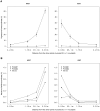Gene flow in genetically modified wheat
- PMID: 22216349
- PMCID: PMC3246478
- DOI: 10.1371/journal.pone.0029730
Gene flow in genetically modified wheat
Abstract
Understanding gene flow in genetically modified (GM) crops is critical to answering questions regarding risk-assessment and the coexistence of GM and non-GM crops. In two field experiments, we tested whether rates of cross-pollination differed between GM and non-GM lines of the predominantly self-pollinating wheat Triticum aestivum. In the first experiment, outcrossing was studied within the field by planting "phytometers" of one line into stands of another line. In the second experiment, outcrossing was studied over distances of 0.5-2.5 m from a central patch of pollen donors to adjacent patches of pollen recipients. Cross-pollination and outcrossing was detected when offspring of a pollen recipient without a particular transgene contained this transgene in heterozygous condition. The GM lines had been produced from the varieties Bobwhite or Frisal and contained Pm3b or chitinase/glucanase transgenes, respectively, in homozygous condition. These transgenes increase plant resistance against pathogenic fungi. Although the overall outcrossing rate in the first experiment was only 3.4%, Bobwhite GM lines containing the Pm3b transgene were six times more likely than non-GM control lines to produce outcrossed offspring. There was additional variation in outcrossing rate among the four GM-lines, presumably due to the different transgene insertion events. Among the pollen donors, the Frisal GM line expressing a chitinase transgene caused more outcrossing than the GM line expressing both a chitinase and a glucanase transgene. In the second experiment, outcrossing after cross-pollination declined from 0.7-0.03% over the test distances of 0.5-2.5 m. Our results suggest that pollen-mediated gene flow between GM and non-GM wheat might only be a concern if it occurs within fields, e.g. due to seed contamination. Methodologically our study demonstrates that outcrossing rates between transgenic and other lines within crops can be assessed using a phytometer approach and that gene-flow distances can be efficiently estimated with population-level PCR analyses.
© 2011 Rieben et al.
Conflict of interest statement
Figures

References
-
- Wolfenbarger LL, Phifer PR. The ecological risks and benefits of genetically engineered plants. Science. 2000;290:2088–2093. - PubMed
-
- Cellini F, Chesson A, Colquhoun I, Constable A, Davies HV, et al. Unintended effects and their detection in genetically modified crops. Food and Chemical Toxicology. 2004;42:1089–1125. - PubMed
-
- Conner AJ, Glare TR, Nap JP. The release of genetically modified crops into the environment. Part II. Overview of ecological risk assessment. Plant Journal. 2003;33:19–46. - PubMed
-
- Snow AA, Andow DA, Gepts P, Hallerman EM, Power A, et al. Genetically engineered organisms and the environment: Current status and recommendations. Ecological Applications. 2005;15:377–404.
-
- Andow DA, Zwahlen C. Assessing environmental risks of transgenic plants. Ecology Letters. 2006;9:196–214. - PubMed
Publication types
MeSH terms
LinkOut - more resources
Full Text Sources

